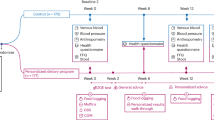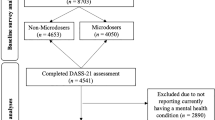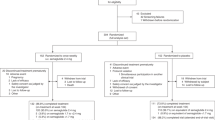Abstract
Background:
Obesity and eating disorders are often studied and treated separately. While the increases in obesity prevalence are well known, examination of its co-occurrence with eating disorders, a problem also of public health concern, is important because eating disorder behaviors are known to contribute to obesity onset and maintenance, and vice versa.
Methods:
Data from large cross-sectional representative statewide community samples of people in the years of 1995 (n=3001), 2005 (n=3047) and 2015 (n=3005) were analyzed. Data were collected using a structured, self-report interview that included demographic, health-related, weight, height and eating disorder behavior questions. Eating behavior questions assessed binge eating, very strict dieting/fasting and purging, and were derived from the Eating Disorder Examination. Logistic regression analyses were conducted comparing prevalence of obesity, eating disorder behaviors and their co-occurrence.
Results:
The prevalence of obesity or binge eating, or obesity with comorbid binge eating, each increased significantly from 1995 to 2005 (P<0.001 for each comparison) and continued to increase significantly from 2005 to 2015 (P<0.001 for each comparison). The highest increases from 1995 to 2015 were in the prevalence of obesity with comorbid binge eating (7.3-fold), or obesity with comorbid very strict dieting/fasting (11.5-fold). The prevalence of very strict dieting/fasting also increased significantly from 1995 to 2015 (3.8-fold). The prevalence of purging, or obesity with comorbid purging, did not change significantly from 1995 to 2015.
Conclusion:
There were statewide increases during the 20 years from 1995 to 2015 in the independent prevalence of obesity, binge eating and very strict dieting/fasting, and even higher increases in the prevalence of obesity with comorbid binge eating, and obesity with comorbid very strict dieting/fasting. These findings support the need for more integrated approaches to both the prevention and treatment of obesity and eating disorder behaviors, namely binge eating and very strict dieting/fasting.
This is a preview of subscription content, access via your institution
Access options
Subscribe to this journal
Receive 12 print issues and online access
$259.00 per year
only $21.58 per issue
Buy this article
- Purchase on Springer Link
- Instant access to full article PDF
Prices may be subject to local taxes which are calculated during checkout
Similar content being viewed by others

References
Collaboration NCDRF. Trends in adult body-mass index in 200 countries from 1975 to 2014: a pooled analysis of 1698 population-based measurement studies with 19·2 million participants. Lancet 2016; 387: 1377–1396.
Hudson JI, Hiripi E, Pope HG Jr, Kessler RC . The prevalence and correlates of eating disorders in the national comorbidity survey replication. Biol Psychiatry 2007; 61: 348–358.
Fairburn CG, Doll HA, Welch SL, Hay PJ, Davies BA, O'Connor ME . Risk factors for binge eating disorder: a community-based, case-control study. Arch Gen Psychiatry 1998; 55: 425–432.
Raman J, Smith E, Hay P . The clinical obesity maintenance model: an integration of psychological constructs including mood, emotional regulation, disordered overeating, habitual cluster behaviours, health literacy and cognitive function. J Obes 2013; 2013: 240128.
Neumark-Sztainer DR, Wall MM, Haines JI, Story MT, Sherwood NE, van den Berg PA . Shared risk and protective factors for overweight and disordered eating in adolescents. Am J Prev Med 2007; 33: 359–369 e3.
Chao YM, Pisetsky EM, Dierker LC, Dohm FA, Rosselli F, May AM et al. Ethnic differences in weight control practices among US adolescents from 1995 to 2005. Int J Eat Disord 2008; 41: 124–133.
Fairburn CG, Welch SL, Doll HA, Davies BA, O'Connor ME . Risk factors for bulimia nervosa: a community-based case-control study. Arch Gen Psychiatry 1997; 54: 509–517.
Ng M, Fleming T, Robinson M, Thomson B, Graetz N, Margono C et al. Global, regional, and national prevalence of overweight and obesity in children and adults during 1980-2013: a systematic analysis for the Global Burden of Disease Study 2013. Lancet 2014; 384: 766–781.
Gammelmark C, Jensen SO, Plessen KJ, Skadhede S, Larsen JT, Munk-Jørgensen P . Incidence of eating disorders in Danish psychiatric secondary healthcare 1970–2008. Aust NZ J Psychiatry 2015; 49: 724–730.
Darby A, Hay P, Mond J, Quirk F, Buttner P, Kennedy L . The rising prevalence of comorbid obesity and eating disorder behaviors from 1995 to 2005. Int J Eat Disord 2009; 42: 104–108.
Fairburn C . Cognitive Behavior Therapy and Eating Disorders. Guilford: New York, USA, 2008.
American Psychiatric Association Diagnostic and Statistical Manual of Mental Disorders 5th edn American Psychiatric Association: Washington, DC, 2013.
Polivy J, Herman CP . Dieting and binging. A causal analysis. Am Psychol 1985; 40: 193–201.
Hsu LK . Can dieting cause an eating disorder? Psychol Med 1997; 27: 509–513.
Polivy J . Psychological consequences of food restriction. J Am Diet Assoc 1996; 96: 589–592 quiz 93-4.
Howard CE, Porzelius LK . The role of dieting in binge eating disorder: etiology and treatment implications. Clin Psychol Rev 1999; 19: 25–44.
da Luz FQ, Hay P, Gibson AA, Touyz SW, Swinbourne JM, Roekenes JA et al. Does severe dietary energy restriction increase binge eating in overweight or obese individuals? A systematic review. Obes Rev 2015; 16: 652–665.
Wang YC, McPherson K, Marsh T, Gortmaker SL, Brown M . Health and economic burden of the projected obesity trends in the USA and the UK. Lancet 2011; 378: 815–825.
Grilo CM, White MA . A controlled evaluation of the distress criterion for binge eating disorder. J Consult Clin Psychol 2011; 79: 509–514.
Araujo DM, Santos GF, Nardi AE . Binge eating disorder and depression: a systematic review. World J Biol Psychiatry 2010; 11: 199–207.
Ariel AH, Perri MG . Effect of dose of behavioral treatment for obesity on binge eating severity. Eat Behav 2016; 22: 55–61.
Palavras MA, Hay P, Touyz S, Sainsbury A, da Luz F, Swinbourne J et al. Comparing cognitive behavioural therapy for eating disorders integrated with behavioural weight loss therapy to cognitive behavioural therapy-enhanced alone in overweight or obese people with bulimia nervosa or binge eating disorder: study protocol for a randomised controlled trial. Trials 2015; 16: 578.
Acknowledgements
This work was supported by the CAPES Foundation, Ministry of Education of Brazil, via a postgraduate scholarship to FQdL, and via the National Health and Medical Research Council (NHMRC) of Australia via a Project Grant and Senior Research Fellowship to AS. The costs of the Health Omnibus Survey questions specific to the present study were funded by internal research grants to PH from the University of Adelaide, James Cook University and Western Sydney University. AS has received payment from Eli Lilly, the Pharmacy Guild of Australia, Novo Nordisk and the Dietitians Association of Australia for seminar presentation at conferences, and has served on the Nestle Health Science Optifast VLCD Advisory Board since 2016. She is also the author of The Don’t Go Hungry Diet (Bantam, Australia and New Zealand, 2007) and Don’t Go Hungry For Life (Bantam, Australia and New Zealand, 2011). ST receives royalties from Hogrefe and Huber, and McGraw-Hill Publishers, and has also been the recipient of an honorarium from Shire Pharmaceuticals. PH receives royalties from Hogrefe and Huber, McGraw-Hill, PLoS Medicine and BioMed Central publishers.
Author information
Authors and Affiliations
Corresponding author
Ethics declarations
Competing interests
The authors declare no conflict of interest.
Rights and permissions
About this article
Cite this article
da Luz, F., Sainsbury, A., Mannan, H. et al. Prevalence of obesity and comorbid eating disorder behaviors in South Australia from 1995 to 2015. Int J Obes 41, 1148–1153 (2017). https://doi.org/10.1038/ijo.2017.79
Received:
Revised:
Accepted:
Published:
Issue Date:
DOI: https://doi.org/10.1038/ijo.2017.79
This article is cited by
-
Children’s eating attitudes test (ChEAT): validation and reliability in Turkish children
Journal of Eating Disorders (2023)
-
Is binge eating associated with poor weight loss outcomes in people with a high body weight? A systematic review with meta-analyses
Eating and Weight Disorders - Studies on Anorexia, Bulimia and Obesity (2023)
-
Epidemiology of eating disorders: population, prevalence, disease burden and quality of life informing public policy in Australia—a rapid review
Journal of Eating Disorders (2023)
-
Physical and mental health outcomes of an integrated cognitive behavioural and weight management therapy for people with an eating disorder characterized by binge eating and a high body mass index: a randomized controlled trial
BMC Psychiatry (2022)
-
Management of eating disorders for people with higher weight: clinical practice guideline
Journal of Eating Disorders (2022)


